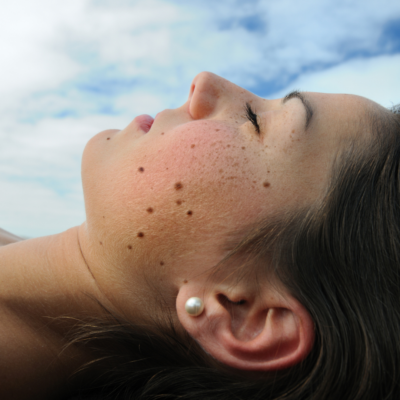Actinic Keratosis
Actinic keratosis, sometimes called solar keratosis, results from cumulative exposure to ultra violet radiation, primarily from sunlight. UV radiation can damage skin cells called keratinocytes on the skin’s outer layer. These sun-damaged cells appear as rough, dry patches averaging an inch in diameter. They emerge individually or in clusters on the skin’s surface, typically in areas most exposed to sunlight, and can appear reddish, dark, or the same color as surrounding skin. Frequent sites include the backs of the hands and ears and/or the face, forearms, neck, and scalp.
Technically not skin cancer, actinic keratosis is considered pre-cancerous. Left untreated, about 10% to 20% of actinic keratosis lesions can progress to squamous cell carcinoma. Unfortunately, there’s no way to predict which ones.
The key is to get actinic keratosis diagnosed and treated as soon as possible. This gives patients the best chance to prevent skin cancer before it starts.
Actinic Keratosis Risk Factors
A personal history of unprotected exposure to sunlight remains the chief risk factor for developing actinic keratosis. Additional risk factors tend to be associated with sun exposure.
Being age 55 or older is a key risk factor. The longer you’ve lived, the more time you’ve had to be exposed to the sun. However, you can also develop actinic keratosis in your 30s or 40s if you’ve used tanning beds or spent significant time in the sun without sun protection.
Statistically, men are at greater risk of actinic keratosis than women, especially men with exposed scalps. Men’s reported reluctance to protect themselves from the sun by using sunscreen and wearing sun protective clothing may be a factor. Though, with more educational outreach about skin cancer risk, that will hopefully change.
Having light-colored skin and eyes also increases risk. That does not mean people with darker skin tones are completely without risk and can skip sun precautions.
Treating Actinic Keratosis
After a thorough visual examination, the trained eye of a board-certified California Skin Institute dermatologist will be able to diagnose actinic keratosis in a suspicious patch of skin. If the dermatologist suspects skin cancer, the area may be biopsied and a treatment plan may await the results. Otherwise, a course of treatment will be prescribed following the actinic keratosis diagnosis. This may include one type of treatment or a mix of two or more depending on individual factors. California Skin Institute offers all current medical options for effective actinic keratosis treatment.
Freezing
This treatment, also called cryotherapy, involves eliminating the actinic keratosis lesions with liquid nitrogen. This is the traditional treatment for actinic keratosis and works best if there are only one or several of these lesions present. Your CSI dermatologist will apply liquid nitrogen to the affected area or areas. After a brief period of blistering and peeling, the area will heal, revealing new and healthy skin.
Topical Creams
Applying a dermatologist-prescribed topical cream at home may be the personal preference of some patients. Topical creams can be a good option for those with highly sensitive skin with concerns about pigmentation changes from other methods. Some creams, like fluorouracil, have chemotherapy-like properties. Others, like imiquimod, can initiate an immunotherapy response. However, these require diligence in applying them once or twice a day for two to six weeks.
Fraxel® Dual Laser
Fraxel® Dual can be a successful treatment strategy for actinic keratosis, especially when it is spread over a larger area, like the backs of the hands or across the forehead. Although the Fraxel® laser is mostly used aesthetically for renewal of the skin’s surface, its ability to target damaged skin cells without harming surrounding tissue offers precise removal of multiple actinic keratosis patches.
Photodynamic Therapy (PDT)
Another multi-dimensional treatment option, photodynamic therapy can also work on areas with multiple actinic keratosis lesions. It functions by emitting specific wavelengths of light that activate an applied topical medication, which then destroys abnormal cells. Its highly specialized technology accomplishes this without emitting any UV radiation. PDT may result in mild redness and flaking for several days, but it can cause less irritation than other treatment options and allow for faster healing.
Disclaimer
This is to be used only as an educational piece. Individuals should not use it to self-diagnose a skin condition or problem.
Treatments for Actinic Keratosis




 / 291 Reviews
/ 291 Reviews